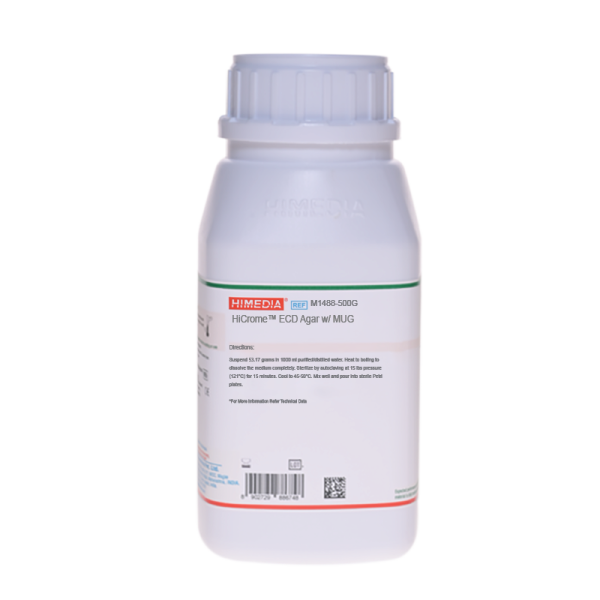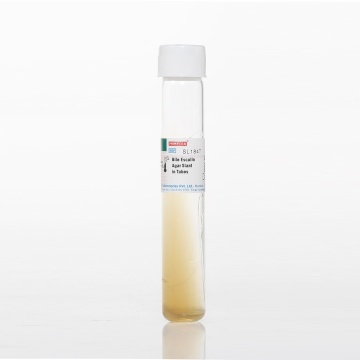 Your enquiry has been submitted
Your enquiry has been submitted
HiCrome™ ECD Agar w/ MUG
Intended use
Recommended for the detection of Escherichia coli in water and food samples by using a combination of chromogenic and fluorogenic substrate.
Composition**
| Ingredients | g / L |
|---|---|
| Tryptone | 20.000 |
| Bile salts mixture | 1.500 |
| L-Tryptophan | 1.000 |
| Lactose | 5.000 |
| Sodium chloride | 5.000 |
| Dipotassium hydrogen phosphate | 4.000 |
| Potassium dihydrogen phosphate | 1.500 |
| Fluorogenic substrate | 0.070 |
| Chromogenic substrate | 0.100 |
| Agar | 15.000 |
Final pH ( at 25°C) 7.0±0.2
**Formula adjusted, standardized to suit performance parameters
Directions
Suspend 53.17 gram in 1000 ml purified/distilled water. Heat to boiling to dissolve the medium completely. Sterilize by autoclaving at 15 lbs pressure (121°C) for 15 minutes. Cool to 45-50°C. Mix well and pour into sterile Petri plates.
Principle And Interpretation
HiCrome™ ECD Agar w/ MUG is recommended for rapid detection of Escherichia coli by using a combination of chromogenic and fluorogenic substrates. The presence of Escherichia coli is indicated by blue coloured colony formation due to cleavage of chromogenic substrate. Fluorogenic substrate permits rapid detection of Escherichia coli when medium is observed for fluorescence using UV light (1,2). Fluorogenic substrate also detects anaerogenic strains, which may not be detected in conventional procedure (1). It is hydrolysed by enzyme ß-D-glucuronidase, possessed by Escherichia coli to yield a fluorescent end product. The reaction is indicated by a blue fluorescence under UV light. Tryptone provides carbon, nitrogen substances, long chain amino acids, vitamins and other essential nutrients. Lactose is the fermentable carbohydrate. Sodium chloride maintains osmotic equilibrium. The medium has a strong buffering system to control the pH in the presence of fermentative action. The bile salt mixture inhibits gram-positive bacteria especially Bacillus species and faecal Streptococci.
Type of specimen
Food samples; Water samples.
Specimen Collection and Handling:
For food samples, follow appropriate techniques for sample collection and processing as per guidelines (3). For water samples, follow appropriate techniques for sample collection, processing as per guidelines and local standards (4). After use, contaminated materials must be sterilized by autoclaving before discarding.
Warning and Precautions :
Read the label before opening the container. Wear protective gloves/protective clothing/eye protection/ face protection. Follow good microbiological lab practices while handling specimens and culture. Standard precautions as per established guidelines should be followed while handling specimens. Safety guidelines may be referred in individual safety data sheets.
Limitations
- ß-glucuronidase is present in 97% of E.coli strains, however few E.coli may be negative.
- Slight colour variation may be observed depending upon the utilization of the substrate by the organism.
- Further biochemical and serological test needs to be carried out for confirmation.
Performance and Evaluation
Performance of the medium is expected when used as per the direction on the label within the expiry period when stored at recommended temperature.
Quality Control
Appearance Cream to yellow homogeneous free flowing powder
Gelling Firm, comparable with 1.5% Agar gel
Colour and Clarity of prepared medium Light amber coloured, clear gel forms in Petri plates
Reaction Reaction of 5.32% w/v aqueous solution at 25°C. pH : 7.0±0.2
pH 6.80-7.20
Cultural Response
Cultural characteristics observed after an incubation at 44-45°C for 18-24 hours.
| Organism | Inoculum (CFU) | Growth | Recovery | Colour of Colony | Fluorescence (under uv) | Indole |
|---|---|---|---|---|---|---|
| Enterococcus faecalis ATCC 29212 (00087*) | >=10⁴ | inhibited | 0% | |||
| Escherichia coli ATCC 25922 (00013*) | 50-100 | good | 40-50% | bluish-green | positive | positive reaction |
| Klebsiella pneumoniae ATCC 13883 (00097*) | 50-100 | good | 40-50% | colourless | negative | negative reaction |
| Pseudomonas aeruginosa ATCC 27853(00025*) | 50-100 | good | 40-50% | colourless | negative | negative reaction |
| Staphylococcus aureus subsp. aureus ATCC 25923 (00034*) | >=10⁴ | inhibited | 0% |
Key : (*) Corresponding WDCM numbers.
Storage and Shelf Life
Store between 15-25°C in a tightly closed container and the prepared medium at 2-8°C. Use before expiry date on the label. On opening, product should be properly stored dry, after tightly capping the bottle in order to prevent lump formation due to the hygroscopic nature of the product. Improper storage of the product may lead to lump formation. Store in dry ventilated area protected from extremes of temperature and sources of ignition Seal the container tightly after use. Product performance is best if used within stated expiry period.
Disposal
User must ensure safe disposal by autoclaving and/or incineration of used or unusable preparations of this product. Follow established laboratory procedures in disposing of infectious materials and material that comes into contact with sample must be decontaminated and disposed of in accordance with current laboratory techniques (5,6).
Reference
- Feng PCS and Hartman PAS, (1982), Appl. Environ. Microbiol. 43:132.
- Lipps WC, Braun-Howland EB, Baxter TE,eds. Standard methods for the Examination of Water and Wastewater, 24th ed. Washington DC:APHA Press; 2023.
- Robinson (1984), Appl. Environ. Microbiol., 48:285.
- Salfinger Y., and Tortorello M.L. , 2015, Compendium of Methods for the Microbiological Examination of Foods, 5th Ed.,American Public Health Association, Washington, D.C.
- Isenberg, H.D. Clinical Microbiology Procedures Handbook. 2nd Edition.
- Jorgensen, J.H., Pfaller, M.A., Carroll, K.C., Funke, G., Landry, M.L., Richter, S.S and Warnock., D.W. (2015) Manual of Clinical Microbiology, 11th Edition. Vol. 1.
| Product Name | HiCrome™ ECD Agar w/ MUG |
|---|---|
| SKU | M1488 |
| Product Type | HiCrome™ |
| Physical Form | Powder |
| Origin | Animal |
| Packaging type | HDPE |
| References | 1.Feng PCS and Hartman PAS, (1982), Appl. Environ. Microbiol. 43:132.2.Robinson (1984), Appl. Environ. Microbiol., 48:285. |
| Customized Product Available | No |








